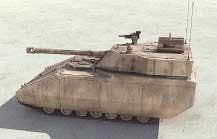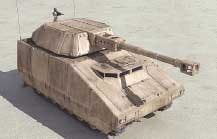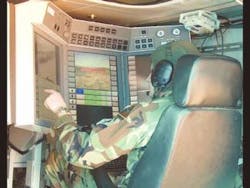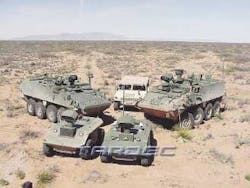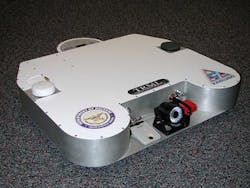The electronic and optoelectronic technologies of the future battlefield will help manned and unmanned vehicles interact with commanders and foot soldiers over global and theater-level radio and telecommunications networks to provide unprecedented situational awareness and maneuver capability to U.S. and allied ground troops. By John Keller
Electronic subsystems and components for U.S. and allied combat land vehicles are entering a fundamentally new and different era of inter- and intra-systems integration with a broad range of new technologies and networked communications. Primarily driving this trend are the overall emphases on "force transformation" and the Future Combat System — better known as FCS.
TOP: This artist's rendering depicts a future main battle tank as envisioned for the Army's Future Combat System. The new tanks will have high-speed networking, advanced vetronics, and will weigh no more than 20 tons so they can be transported aboard C-130 cargo aircraft. CENTER:This robotic version of the U.S. Army Light Armored Vehicle is to demonstrate autonomous navigation and high-speed data links that ultimately may lead to the first unmanned combat ground vehicles. BOTTOM: This artist's rendering of a future lightweight self-propelled artillery system will be fast, lightweight, and will be deployable anywhere worldwide in as little time as 96 hours.
The new transformational era will usher in advanced technologies in vehicle electronics (vetronics) such as nuclear/ biological/chemical sensors, automatic target recognition, computer-based decision aids, ultrasonic/infrared/visible-light sensors, laser radar (LADAR), high-speed distributed computing, robotics, low-profile conformal antennas, position/navigation/tracking systems, disposable unattended sensors, battle command on- the-move systems, through-wall and through-foliage sensors, standoff mine detection, unmanned vehicles, high-speed wireless mobile networks, advanced machine navigation, sensor fusion, optoelectronic countermeasures, flexible and conformal color displays, and charge-coupled-device (CCD) cameras.
The transformational philosophy of weapon system design, acquisition, and deployment seeks to catapult the notion of an integrated architecture from a platform level literally to a global level.
Today, the standard for vetronics integration is embodied in the M1A2 Abrams main battle tank and the M2A3 Bradley Fighting Vehicle. The Abrams and Bradley vetronics architectures link onboard electronic subsystems, such as sensors and computers, in real time on a 1-mebagbit-per-second MIL-STD-1553 databus. Systems are integrated on each vehicle, but connecting the vehicles, foot soldiers, and commanders for the most part are only secure data and voice radios. Transformation would move that connectivity ahead by light years.
The transformational approach not only seeks to continue and enhance integrated vetronics architectures, but it seeks to link ground vehicles, foot soldiers, command posts, combat aircraft, unmanned aerial vehicles, national command authorities, and satellite communications systems via high-speed wireless and wired networks to help fighting forces move faster, fight harder, survive better, and maneuver more intelligently than they ever have before.
Designers from the U.S. Army and General Dynamics Corp. are designing the combat vehicle crew station of the future, which will control the vehicle, handle communications, and even control unmanned ground and air vehicles. Pictured is the Army's Crew Integration and Automation Test Bed Advanced Technology Demonstration that shows crew interfaces, automation, and integration technologies.
This technological transformation is to create an ocean of information available to anyone on the battlefield who needs it, similar to what the Internet provides to homes and businesses today. Each vetronics architecture is to be integrated to create an intelligent and comprehensive picture of what its operators see and experience on the battlefield, but would be able to share that information in real time with all other friendly forces on the battlefield.
Transforming the fighting force
The concept of transformation has three primary components: networking, automation, and situational awareness. Vetronics will be a core enabler of all three capabilities.
Networking seeks to link all elements of the fighting force in real time — from top commanders and national command authorities, to foot soldiers in the fox hole. High-speed terrestrial on-the-move networks will link with theater-level wired networks, which in turn will link with high-speed ultra-broadband satellite networks to make this goal a reality. Advanced Internet Protocol communications are to create an "infosphere," from which commanders and foot soldiers alike can draw data on the locations and capabilities of friendly forces and enemies.
Automation seeks to augment the manned fighting forces with unmanned ground vehicles and aircraft that will handle a wide variety of battlefield missions, such as resupply, reconnaissance and surveillance, and even directly engaging the enemy. A chief enabler — and technological goal of transformation — is real-time reliable machine navigation to help unmanned ground vehicles negotiate difficult terrain to keep pace with fast-moving fighting forces.
Automation and robotics are cornerstones of the U.S. Army's new emphasis on transformational vehicle electronics. Pictured above are autonomous or semi-autonomous versions of (clockwise from left) the Light Armored Vehicle (LAV), the High Mobility Multi-Wheeled Vehicle, a surveillance version of the LAV, and two experimental unmanned ground vehicles designed to demonstrate a robotic follower.
Situational awareness has been a tactical military goal for decades, and transformation seeks to make it a reality. Situational awareness relies on a broad array of tightly networked RF, optical, and acoustic sensors, advanced computer processing to distill critical information quickly from oceans of sensor data, Internet-type networking to share crucial information with those on the battlefield who need it most, and advanced graphical processing and displays to enable warfighters to understand conditions on the battlefield at a glance.
Future Combat System
The FCS is where U.S. military planners will put the concept of transformation into practice. In military parlance, FCS is to be a "system of systems" that uses a network that tightly links about 18 separate systems together with foot soldiers and their commanders. The idea is to link warfighters with manned and unmanned ground vehicles and aircraft, as well as with a wide variety of sensors to create a rich picture of the battlefield situation.
Armed with such a dynamic picture, or with this kind of "situational awareness," U.S. forces theoretically could maneuver against opposing forces without making direct contact, strike in the time and place of their choosing, mass fire against opposing forces without massing their own forces, keep their eyes continually on targets, and decentralize decision making.
The U.S. Army is the lead military service on the FCS program, while Boeing Integrated Defense Systems in St. Louis and Science Applications International Corp. (SAIC) in McLean, Va., are the project's lead systems integrators, and act as general contractors that choose integrators, suppliers, technologies, and subsystems. FCS is to be fielded in 2010.
The manned-vehicle component of FCS revolves around a wheeled platform similar to the General Dynamics Light Armored Vehicle (LAV) chassis. This common 20-ton chassis is to be the foundation for a new generation of battle tanks, artillery systems, armored personnel carriers, command-and-control vehicles, armored reconnaissance vehicles, battlefield ambulances, and combat engineering vehicles.
These vehicles, which are set first to augment, and then to replace the Abrams tank and the Bradley Fighting Vehicle, are being designed to accommodate two-person crews, yet some of them will employ robotic technology to operate autonomously or semi-autonomously for tasks such as reconnaissance and battlefield resupply. These vehicles are to be air-transportable aboard aircraft as small as the Lockheed Martin C-130 four-engine turboprop.
Vetronics on manned platforms
The existing generation of Abrams and Bradley combat vehicles primarily use custom-designed electronic and optoelectronic systems and subsystems, while using commercial off-the-shelf (COTS) components such as integrated circuits, circuit boards, and networking hardware. FCS, meanwhile, will continue the use of COTS, but will reduce or eliminate the use of custom-designed subsystems, and rely heavily on commercially developed technology.
"We capitalize on where industry is going, and try to get them to support our needs," says Dr. Grace Bochenek, executive vice president for research, and technical director of the U.S. Army Tank, Automotive & Armaments Command (TARDEC) in Warren, Mich.
FCS vetronics designers envision integrated architectures — such as those of the Abrams and Bradley — yet will build with broadband networks in mind for inside and outside of the vehicles. While the Abrams and Bradley rely on the 1553 wired databus, future FCS vehicles will rely on Gigabit Ethernet, and the IEEE 802.11 wireless data network. Networking choices mostly will likely change over time with evolving commercial technology advances.
FCS vetronics architectures also will differ from those of the Abrams and Bradley in terms of software integration. While the Abrams and Bradley vetronics are tightly integrated at the hardware level, FCS vetronics will be integrated primarily at the software level to broaden options for hardware subsystems choices and technology refresh, explains Kenneth Mick, director of vetronics and fightability at General Dynamics Land Systems (GDLS) in Sterling Heights, Mich. GDLS, along with United Defense LP in Arlington, Va., form the integrated design team for the FCS manned ground vehicle portion, and are working directly with the Boeing/SAIC lead systems integrator.
"In the Abrams we did a systems-integration approach, and developed it to incorporate subsystems," Mick explains. "FCS is more integrated at a software level rather than a hardware-subsystems level. We want to hook sensors right into a central box, and centrally locate processing."
The role of Stryker
The U.S. Army General Dynamics Stryker program, which uses the Light Armored Vehicle chassis for a variety of new combat vehicles, is a technological interim step in the evolution from the Abrams and Bradley to the FCS vehicles.
Among the more interesting — and temporary — aspects of Stryker is its lack of tightly integrated vetronics architecture, Mick explains. "In the architecture employed in Stryker you adapt for new technologies, especially if it is C4I [command, control, communications, computers, and intelligence]," Mick says. "Stryker implements it as an appliqué, or add-on. Stryker is not a distributed system; you cannot offload one processor onto another processor."
The Stryker vehicle family — the first new military vehicle to enter U.S. Army service since the Abrams tank in the 1980s — includes an infantry carrier; mobile gun system; nuclear, biological, chemical reconnaissance vehicle; anti-tank guided-missile vehicle; medical- evacuation vehicle; mortar carrier; engineer-squad vehicle; command vehicle; fire-support vehicle; and reconnaissance vehicle (RV).
Although the Stryker vehicles do have databuses — the CAN automotive bus, and RS 232, "it is not as sophisticated an architecture as the Abrams," Mick says. "It has no ability to move processing data in real time. Stryker was to be a bridge from Abrams to the FCS; it does the job, but we see FCS as more Abrams-like."
Future FCS vehicles
Not only will the FCS vehicles have Gigabit Ethernet and IEEE 802.11 information networks, but developers are also considering other networks or databuses for even more data throughput. "We are looking at some high-speed databus for closed-loop control for determinism," Mick says. "We looked at Firewire, 1553, Fibre Channel, and FDDI, and then we looked at low-level automotive buses, like a CAN bus."
FCS vetronics integrators are looking into blending several channels of Gigabit Ethernet over one strand of optical fiber aboard the FCS vehicles to increase throughput, as well as save space and lighten weight, Mick says. "We are trying to patent something, and it may be WDM [wavelength-division multiplexing]," he says. "At our data rates, we have to make optical work; we don't have any choice."
Working with General Dynamics Land Systems on FCS vetronics are General Dynamics Robotic Systems Inc. in Westminster, Md.; General Dynamics Advanced Information Systems in Arlington, Va., and General Dynamics C4 Systems in Taunton, Mass. General Dynamics Robotics is building sensor systems and autonomous navigation capability FCS vehicles, General Dynamics Advanced Information Systems is building the onboard computers for FCS, and General Dynamics C4 is integrating command-and-control systems and mobile networks to support FCS combat vehicles.
Mick says FCS vehicle designers may need several commercially available power buses to handle power demand potentially for anywhere from 600 to 900 volts, plus a 24-volt base system. Also under consideration is building a custom-designed power bus to handle all power needs aboard FCS vehicles, he says.
Such high-power loads bring cooling issues to the forefront, and Mick says spray cooling is under consideration, as are more traditional cooling methods of forced-air convection cooling, and heat-sink conduction cooling.
Tactical networking
The networking glue that will join vehicles, commanders, and foot soldiers in the FCS project is called the Warfighter Information Network-Tactical — better known as WIN-T. This future high-speed and high-capacity backbone communications network will use land-based wired and wireless communications systems, manned and unmanned aircraft, as well as satellites to create the military data "infosphere" that defense planners have been seeking for decades.
The WIN-T will enable all Army commanders, national command authorities, and tactical forces in the field to exchange information with wired or wireless telephones, computers, video terminals, the future Joint Tactical Radio System (JTRS) inside combat vehicles, and most likely with relatively old existing military communications systems such as the Mobile Subscriber Equipment (MSE), and the Tri-Service Tactical Communications System (Tri-Tac).
Military planners expect the WIN-T program to set standards and protocols for FCS applications and network hosts not only to provide broad-area real-time data networking, but also to create "networking on the move," where theater-level networks remain intact during fast-moving tactical operations. Existing systems such as MSE must have their network nodes at fixed sites to keep the network in operation.
General Dynamics Corp. and Lockheed Martin Corp. were the finalists in competition to design and build WIN-T at presstime, with one winner expected soon. It is likely that both companies will have substantial stakes in future WIN-T development.
Companies working with General Dynamics in the WIN-T competition include BAE Systems, BBN Technologies, DynCorp, General Dynamics Decision Systems, Laguna Industries Inc., Log.Sec Corp., Northrop Grumman Corp., OPNET Technologies, Solers, and Veridian.
Automation and unmanned vehicles take center stage in vetronics development
U.S. Army vehicle electronics (vetronics) designers are shifting virtually all their research-and-development money over to robotics and unmanned systems, and are looking to commercially developed technology to meet their future needs in manned vetronics systems.
"For the vetronics tech base we rely on the commercial market now," says Dr. Grace Bochenek, executive vice president for research, and technical director of the U.S. Army Tank, Automotive & Armaments Command (TARDEC) in Warren, Mich.
"Over the last four to five years there has been a shift in our R&D investment," Bochenek says. "We have migrated to investments in unmanned ground platforms. All the Army's investment is in automation and unmanned systems."
Army leaders see automation and unmanned systems as important ways not only to reduce the number of crew members necessary to operate combat vehicles on the battlefield, but also to reduce the number of human beings who must operate vehicles in dangerous areas.
The 80-ton M1 Abrams main battle tank, for example, requires a crew of four to run the machine — driver, commander, gunner, and loader. The 20-ton combat vehicles envisioned for the U.S. Army's Future Combat System (FCS), on the other hand, will have crews of two.
"Intelligent systems are a big part of the Future Combat System," Bochenek says. At the heart of the Army's plan to increase automation and reduce crew size in future combat vehicles is a project to develop a multimission common crew station for platforms such as the Stryker interim combat vehicle, and the future FCS vehicles.
Not only would this multimission common crew station enable two-man crews to control their own vehicle, keep in touch with other vehicles in the area and with their commanders, and keep track of the locations of friendly and enemy forces, but the station also would enable them to control unmanned ground and air vehicles.
At the moment, this project revolves around the Crew Integration and Automation Test Bed Advanced Technology Demonstration, otherwise known as CAT-ATD. This project is to demonstrate the crew interfaces, automation, and integration technologies necessary to meet the future needs of two-man combat vehicle crews.
The CAT-ATD seeks to design a wrap-around reconfigurable display that would help crewmembers drive the vehicle with sensors and the wrap-around display, rather than by using a direct view outside the vehicle. The crew station will also demonstrate automated decision aids, ways for crewmembers to dip into a rich supply of real-time battlefield information, and help the crew practice missions and hone their skills with embedded simulation and computer-generated mission rehearsal.
The demonstrator is to showcase soldier-machine interface technology, indirect vision, speech recognition, 3-D audio, helmet-mounted displays and panoramic displays, as well as automated route planning, driving, and battle planning. The station will blend information from sensors, weapons, and unmanned vehicles.
A sister project to the CAT-ATD at Army Tank-Automotive Command is the Robotic Follower Advanced Technology Demonstrator (Robotic Follower ATD) project. This program focuses on developing a low-risk, near-term autonomous vehicle to handle tasks such as equipment carrier, resupply, scouting, mine detection, rear-area security, unmanned-aerial-vehicle launch, and fire support.
This vehicle will incorporate second-generation laser radar, forward-looking infrared sensors, and advanced computers to handle autonomous navigation, which experts point out is one of the most difficult challenges to building autonomous vehicles.
For the autonomous follower, Army planners want to data-link terrain data from the lead vehicle back to the follower vehicle to augment data the follower vehicle gathers from on-board sensors and from its Global Positioning System (GPS), Bochenek says.
The idea is to pass "electronic bread crumbs" from the manned lead vehicle back to the autonomous follower vehicle, or provide high-level proofing of the follower's path so the follower avoids areas that might impede or confuse its autonomous navigation system, while requiring only a minimum of human intervention and control from the lead vehicle.
One of the program's goals is to build an autonomous vehicle capable of driving on primary roads at speeds of 50 to 60 miles per hour, and driving off-road at 40 miles per hour. The vehicle should operate at distances of three to six miles from the lead vehicle.
At the moment, planners plan to use the VME backplane and Intel Pentium-based computers for the autonomous follower, and in the future are looking into designing a new general-purpose processor to integrate onto the vehicle. The vehicle's software is expected to be Windows XP embedded for routine tasks, and Wind River VX Works for real-time mission-critical tasks.
For the future, Army researchers would like to develop an armed autonomous vehicle, possibly within the next three to four years.
Remotely operated vehicle-inspection robot sees duty in Iraq
Researchers from the U.S. Army and the University of Utah developed a remote-control robot, which has been deployed to Iraq and Afghanistan, that inspects the undersides of cars and trucks for explosives, while keeping the robot's operator out of harm's way.
Called the Omni-Directional Inspection System — or ODIS, for short — the robot is an alternative to the "mirror-on-a-stick" inspection method for detecting explosives, suspicious modifications, and contraband on the undercarriages of highway vehicles.
The 4-inch-high ODIS has several onboard computers, camera, and active lighting. The robots also can be fitted with radiation sensor, chemical detector, or loudspeaker so the robot controller can communicate with vehicle drivers.
The operator controls the robot from as far away as 100 yards with an operator control unit integrated into a vest and thigh pack. The control unit has a 6.8-inch video screen and multifunction joystick for one-hand operation.
Twenty ODIS robots went to Iraq and Afghanistan last spring, where they went into use at active checkpoints.
Additional early production robots may be available for duty in Iraq and Afghanistan this fall. Kuchera Industries in Windber, Pa., assembles the ODIS.
In addition to military use, ODIS has potential use for a wide range of homeland-security applications, says Dr. Grant Gerhart, senior research scientist at the U.S. Army Tank-Automotive and Armaments Command in Warren, Mich.
ODIS is also seeing experimental use at the ports of Los Angeles and Long Beach, Calif., where 18-wheeler semi-trailer trucks can form lines for as long as a mile waiting for inspections before entering the ports.
